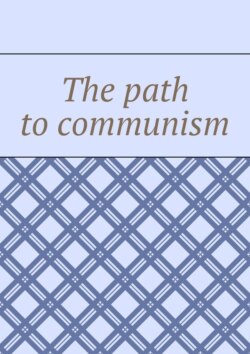The path to communism

Реклама. ООО «ЛитРес», ИНН: 7719571260.
Оглавление
Denis Burenko. The path to communism
INTRODUCTION
Chapter 1. Primitive society
Chapter 2. Slave society
Chapter 3. Feudal society
Chapter 4. Capitalist society
Chapter 5. Imperialist Society
Chapter 6. Socialist society
Chapter 7. Communist Society
Features of communism
MAIN CONCLUSIONS
Sources
Отрывок из книги
Hello dear person! I see that you are not indifferent to the fate of your country, since you are now reading these lines. Me too! Since you are reading these lines, then surely not everything is so smooth in your state. And you want to change this world. You want democracy to reign in your country, social justice to be present, so that the level of well-being of the population is at a high level. Fortunately, I am not the only one who has tried to do this. I have a certain “food” on which I am writing these lines. Karl Marx and Friedrich Engelsoverturned the idea of the laws of development of nature and society. They were able to prove that the most important causes of social contradictions are not related to cultural, linguistic and geographical differences, as bourgeois ideologists claim. The development of society depends primarily on who owns large property and the means of production, how the owners dispose of them, and how equitably the wealth created by labor is distributed. It is economic relations that determine all aspects of human life: politics, law, the state and its institutions, culture, ideology, religion, art, worldview and morality. Vladimir Lenin was able to test this in practice, proving that these are not utopian ideas, but real prospects, having implemented the socialist revolution, and thereby establishing the rule of the proletariat (working class). Now in the world there are two main economic systems: antisocial (aimed at oppressing the majority of people) and social (aimed at the domination of social justice for all people and excluding the exploitation of other people’s labor). In this book, we will describe the historical development of society. We will prove that the main principle of the antisocial system of the economy is the exploitation of man by man = social inequality has always been and is. And with the” peaceful economic modernization of the antisocial system of the economy” continued to exist. But the principle of the social system of the economy from each according to his ability to each according to his work = social equality is a principle that is possible only with a revolution. And not in a bourgeois-democratic revolution, but in a proletarian (people who make (workers and peasants)) revolution. All these “scientific expressions” incomprehensible to us, like: socialism, capitalism, democracy, revolution, classes: the proletariat and the bourgeoisie and others, we will analyze in the course of our research.
The accumulation of production experience by ancient people and the improvement of labor skills led to the creation of a new type of labor tools, with the help of which it was possible to chop, cut, saw, drill. Drilling and grinding of stone contributed to the creation of combined tools (stone ax, spear with a sharpened flint blade). The invention of the bow and arrow dramatically increased the efficiency of hunting, made it possible for individual hunting for small animals. The meat obtained in the hunt becomes a constant human food. This played an important role in strengthening the settled way of life and contributed to the gradual transition to a production-type economy. At the same time, the domestication of wild animals began.
.....
So, how were the most important decisions for the tribal community made? As we have said earlier, the economic relations determine all aspects of human life. This means both the social well-being of the tribal community and social equality depend on the form of ownership of the means of production. As we have already said, the region had collective property and was engaged in the economy on the basis of the gender and age division of labor. What is collective property? And what place do people who produce and work occupy in it? Collective property is a form of ownership in which all members of the collective have equal rights to its ownership and use, as well as to equal participation in the disposal of the results of labor. Accordingly, such an economy can be called command or planned.
The management and power of the clan community belonged to the general assembly of the clan – the supreme governing body. The elder is the oldest and most experienced member of the clan community. His power was provided by his life experience, knowledge of traditions and customs. Elder directs silt hozyays Twain and social life of the tribal community, allowed the debate within the genus.
.....